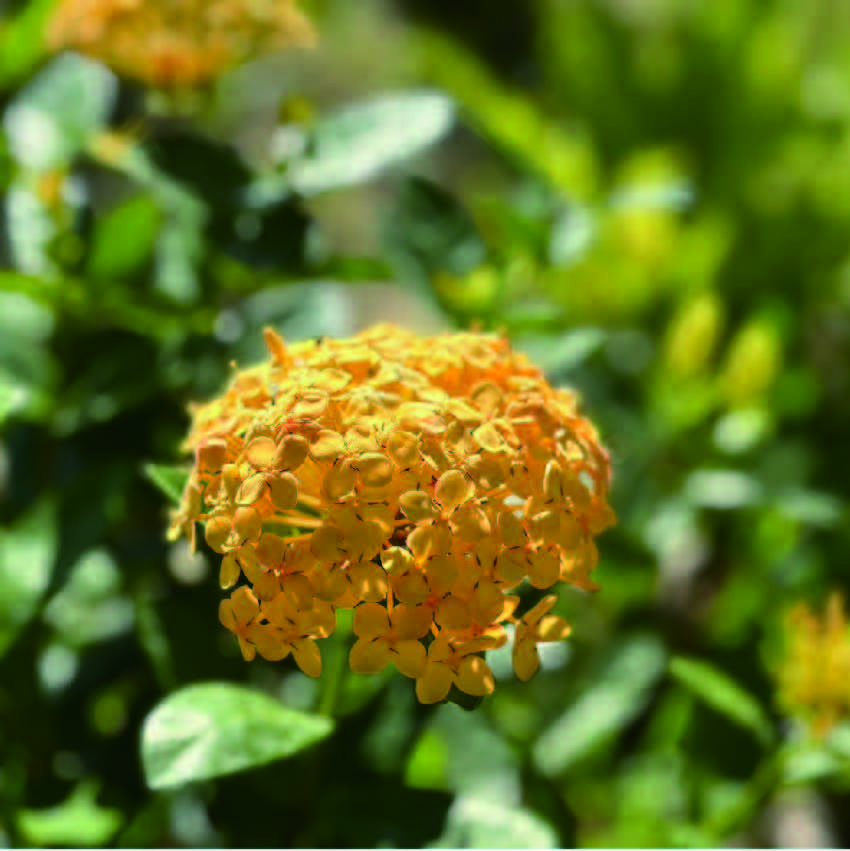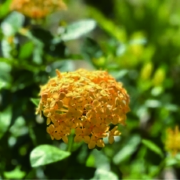仙丹花 Ixoro chinensis

仙丹花 Ixoro chinensis
仙丹花(學名:Ixora chinensis)又稱為山丹花
其他還有紅繡球、買子木、賣子木、三段花等別名,英文名稱為Chinese ixora。
常綠灌木,原產於中國南方與馬來西亞一帶,一般常見的多數為橙紅色的花。
為「沖繩三大名花」之一,是沖繩縣宇流麻市的市花。
形態 :
仙丹花全株側枝向上挺直生長且平滑,葉子表面光滑革質對生,全緣而呈倒卵形狀或是橢圓形。一般長度約9公分-12公分左右,寬約4公分-5公分。表面是深綠色,背面的顏色較淺。而洋仙丹花的葉片形狀則呈托葉三角形或長橢圓形,表面的葉脈比較明顯。葉子的出梢期第一次大約在每年的3月-6月之間,第二次約在8月到10月上旬左右。
至於洋仙丹花雖然也是一樣有20-30朵小花聚集生長,但是其外型大多為半圓型狀,且花瓣比較尖長。在日本的沖繩因為此花的花期一年有三次,加上花梗為三段是重疊的狀態,所以也有「三段花」的別稱。
仙丹花的花期很長,一般來說在每年的4月下旬到翌年的1月下旬左右均可以看見開花,其中盛花期大約是在5月中旬到11月下旬。也有球形的漿果會長成,但是一般平常的時候大多是不結果實,所以很少能看到結果的仙丹花。
引用資料 : https://zh.wikipedia.org/zh-tw/%E4%BB%99%E4%B8%B9%E8%8A%B1
Ixoro chinensis
Ixora chinensis (scientific name: Ixora chinensis) is also called mountain dandelion.
There are other aliases such as red hydrangea, maizimu, maizimu, and three-stage flower. The English name is Chinese ixora.
It is an evergreen shrub native to southern China and Malaysia. Most of the common flowers are orange-red.
It is one of the “Three Famous Flowers of Okinawa” and the city flower of Uruma City, Okinawa Prefecture.
Form:
The lateral branches of the whole plant of Ixora grow straight upward and are smooth. The leaves are smooth and leathery on the opposite surface, and the edges are entire and obovate or oval in shape. Generally, the length is about 9cm-12cm, and the width is about 4cm-5cm. The surface is dark green and the back is lighter. The leaves of Ixora are stipulated in a triangular or oblong shape, with obvious veins on the surface. The first leaf emergence period is between March and June every year, and the second time is around August to early October.
As for the elixir, although it also has 20-30 small flowers growing together, most of them are semicircular in shape, and the petals are relatively pointed and long. In Okinawa, Japan, this flower blooms three times a year, and the pedicels are in three overlapping sections, so it is also known as the “three-section flower”.
The flowering period of elixir is very long. Generally speaking, it can be seen blooming from late April to late January of the following year. The peak flowering period is from mid-May to late November. There are also spherical berries that will grow, but most of them usually do not bear fruit, so it is rare to see fruiting elixirs.
Citation information: https://zh.wikipedia.org/zh-tw/%E4%BB%99%E4%B8%B9%E8%8A%B1




